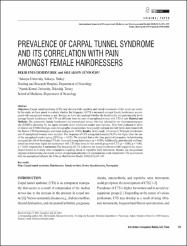| dc.contributor.author | Demiryurek, Bekir Enes | |
| dc.contributor.author | Gündoğdu, Aslı Aksoy | |
| dc.date.accessioned | 2022-05-11T14:40:17Z | |
| dc.date.available | 2022-05-11T14:40:17Z | |
| dc.date.issued | 2018 | |
| dc.identifier.issn | 1232-1087 | |
| dc.identifier.issn | 1896-494X | |
| dc.identifier.uri | https://doi.org/10.13075/ijomeh.1896.01068 | |
| dc.identifier.uri | https://hdl.handle.net/20.500.11776/8925 | |
| dc.description.abstract | Objectives: Carpal tunnel syndrome (CTS) may develop with repetitive and forced movements of the hands and wrists. In this study, we have aimed to evaluate whether the frequency of CTS is increased amongst female hairdressers as compared with unemployed women or not. Besides, we have also analyzed whether the functionality and pain intensity levels amongst female hairdressers with CTS are different from the ones of unemployed women with CTS or not. Material and Methods: The consecutive female hairdressers and unemployed women who had referred to our electroneuromyography (ENMG) laboratory for the upper extremity nerve conduction studies were included. They were evaluated in terms of clinical and ENMG findings, socio-demographic characteristics, functionality and pain intensity levels determined with the Boston CTS Questionnaire and visual analog scale (VAS). Results: In this study, 110 women (70 female hairdressers and 40 unemployed women) were included. The frequency of CTS among hairdressers (74.3%) was higher than the one of the unemployed control group (55%) (p = 0.032). We detected that as the time period of occupation in hairdressing increased, the risk of developing CTS also increased among hairdressers (p < 0.001). Additionally, pain intensity and functional loss levels were higher for hairdressers with CTS than those for the control group with CTS (p = 0.005, p < 0.001, p = 0.028, respectively). Conclusions: The frequency of CTS is elevated for female hairdressers with respect to the unemployed women as in many other occupations requiring forced or repetitive hand movements. Besides, the occupational exposure in hairdressing also results in more elevated pain intensity and functional loss levels related with CTS as compared with the unemployed subjects. | en_US |
| dc.language.iso | eng | en_US |
| dc.publisher | Nofer Inst Occupational Medicine, Sw | en_US |
| dc.identifier.doi | 10.13075/ijomeh.1896.01068 | |
| dc.rights | info:eu-repo/semantics/openAccess | en_US |
| dc.subject | Pain | en_US |
| dc.subject | Carpal tunnel syndrome | en_US |
| dc.subject | Hairdressers | en_US |
| dc.subject | Female workers | en_US |
| dc.subject | Boston Questionnaire | en_US |
| dc.subject | Neuropathy | en_US |
| dc.subject | Occupational Risk-Factors | en_US |
| dc.subject | Boston Questionnaire | en_US |
| dc.subject | Functional Status | en_US |
| dc.subject | Syndrome Severity | en_US |
| dc.subject | Nerve-Conduction | en_US |
| dc.subject | Syndrome Cts | en_US |
| dc.subject | Population | en_US |
| dc.subject | Symptoms | en_US |
| dc.subject | Index | en_US |
| dc.title | Prevalence of Carpal Tunnel Syndrome and Its Correlation with Pain Amongst Female Hairdressers | en_US |
| dc.type | article | en_US |
| dc.relation.ispartof | International Journal of Occupational Medicine and Environmental Health | en_US |
| dc.department | Fakülteler, Tıp Fakültesi, Dahili Tıp Bilimleri Bölümü, Nöroloji Ana Bilim Dalı | en_US |
| dc.identifier.volume | 31 | en_US |
| dc.identifier.issue | 3 | en_US |
| dc.identifier.startpage | 333 | en_US |
| dc.identifier.endpage | 339 | en_US |
| dc.institutionauthor | Gündoğdu, Aslı Aksoy | |
| dc.relation.publicationcategory | Makale - Uluslararası Hakemli Dergi - Kurum Öğretim Elemanı | en_US |
| dc.authorscopusid | 55981359800 | |
| dc.authorscopusid | 57190847841 | |
| dc.identifier.wos | WOS:000418805300007 | en_US |
| dc.identifier.scopus | 2-s2.0-85039963167 | en_US |
| dc.identifier.pmid | 29063909 | en_US |



















